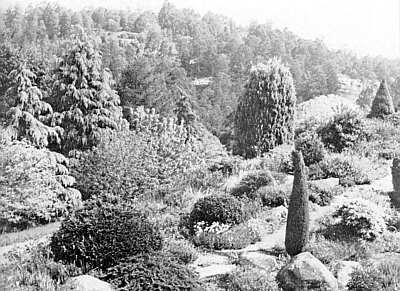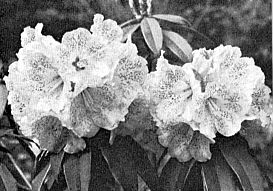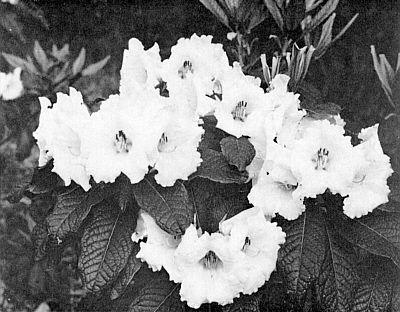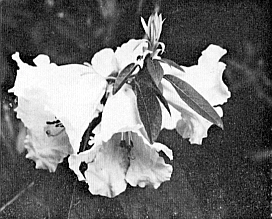QBARS - v26n2 Rhododendrons at Pirianda Olinda, Mt. Dandenong
Rhododendrons at Pirianda Olinda, Mt. Dandenong
A. W. Headlam, Bentleigh, Australia

|
|
FIG. 46. Part of the extensive rock-garden at Pirianda in
which conifers and a wide collection of dwarf plants are grown. |
Pirianda (native word for sufficient), the home of Mr. and Mrs. Harvey Ansell, is located in the Dandenong ranges some thirty miles east of Melbourne. The elevation ranges from 1,500 feet, the highest point at the entrance gate to 1,200 feet at the lowest extremity of the garden. The fall of the land is approximately one in four, and the road from the entrance gate winds through an area under grass planted with specimen trees, which should, as they mature, provide interest and beauty, as they have been planted with emphasis upon those producing good color in the fall, amongst which are Franklinia alatamaha, Nyssa sylvatica and Lindera triloba from the U.S.A., and a fairly recent introduction from China, Rehderodendron macrocarpum , a fine small deciduous tree.
As the road nears the house it turns sharply, and on the inside of the bend, which is enclosed by rock-walls built from stone collected on the property, is a magnificent planting of Mollis Azaleas, 'Koster's Brilliant Red', 'Dr. Oosthoek', through the orange, yellows and pinks, and these also make a brilliant display in the late fall, when the leaves turn to scarlet and russet shades before they finally fall to the ground.
The garden, in all, covers an area of twenty acres, and the rich, acid, volcanic well drained soil, combined with a rainfall of some fifty inches, spread fairly evenly over the year, is particularly suitable for the growing of ericaceous plants. Soil was bulldozed from the hillside to provide a flat area upon which to build the house, in fact, this is probably the only flat piece of ground in the whole twenty acres.
An extensive rock-garden occupies an area in front of and along one side of the house, and it has been planted with dwarf conifers and prostrate growing plants, dwarf rhododendrons, Daphne cneorum, Daphne genkwa , alpines and bulbs so as not to restrict the magnificent views of the garden and valley below, which may be seen from the large plate glass windows extending along one side of the house.
The property was purchased by the present owners in 1959, so that in the main it is quite a young garden, fortunately however, there was already present a nucleus of mature trees planted by the previous owners. These include a fine row of eleven Copper Beeches ( Fagus sylvatica 'Cuprea'), mature specimens of various conifers, of particular beauty being Picea smithiana , the West Himalayan Spruce, with its soft drooping branches, some deciduous trees, and a number of old hybrid rhododendrons, the largest of which is 'Broughtonii', about twenty five feet in height. It makes an attractive sight when in flower, and has a massive trunk which divides into multiple branches a few feet above the ground.
An impressive background to the whole garden is provided by the fine stands of Blackwoods ( Acacia Melanoxylon ), and Mountain Ash ( Eucalyptus regnans ), the latter growing true and straight to 200 feet and more before they branch out, and are exceeded in height only by the Californian redwoods.
A walk around the garden, commencing at the house, leads downwards past the Mollis Azaleas, and on crossing the road, there is another large rock-garden, again built from rock collected on the property, the same source having supplied the stone used in the extensive and attractive rock-walling seen throughout the garden.
On a slope above the rock-garden is a planting of rhododendrons, and one which attracts considerable attention is a lovely well rounded plant of 'Alison Johnstone', with its profusion of apricot shaded flowers, and in the background two outstanding pinks, each carrying enormous trusses, 'Coronation Day', which appreciates a sheltered position, and 'Sir Frederick Moore', a R. discolor hybrid which is not so demanding as regards shelter; these are set off to advantage by a plant of R. vernicosum , with its attractive seven-lobed white flowers with crimson markings.
The path then leads downwards, and a large specimen of Pieris forrestii comes into view, its new foliage in brilliant shades of scarlet. A small crystal clear stream is then crossed, and its banks have been planted with Primula japonica which hybridize and increase naturally, their feet are continuously wet and they make an attractive foil for a bank of Kurume Azaleas which have been planted along a rock wall following the stream; a highlight is a group of Acer palmatum 'Dissectum Atropurpureum' which overhang the rock wall, and on a slope in the background are a group of Exbury Azaleas, which flower later than the Mollis, and their blaze of color can be seen from a number of vantage points in the garden.
A well graded path leads down the slope, on both sides of which are plantings of rhododendrons, Ajuga reptans has been used very successfully as a ground cover on slopes too steep to plant with grass for mowing and their spikes of blue flowers make an attractive background for rhododendrons in the white, cream and yellow tonings, 'China', R. wardii , R. wightii and two attractive small growing species, R. hanceanum var. nanum , only six inches high and covered with small yellow flowers, R. valentinianum another compact small growing plant, covered also with bright yellow flowers, and in the background, a large specimen of 'Alice Street', set off to advantage against the blue Ajuga, and probably one of the best yellow hybrids in the garden.
Then along the rock-walls, R. campanulatum var., aeruginosum , a small plant which has not yet flowered, but R. campanulatum var. 'Knaphill' has produced flowers of a pleasing shade of lilac, and R. parmulatum , with foliage dark green above and glaucous below, is another imported plant yet to flower, R. bullatum , Series Edgeworthii, with its unusual dark green bullate foliage and funnel shaped white flowers flushed pink, makes an interesting contrast, and a compact growing hybrid, 'Helene Schiffner', with its profusion of glistening white flowers completes the picture.
Two forms of R. tephropeplum growing side by side provide an interesting contrast, one with the usual lavender pink flowers, and the other form with somewhat smaller flowers shaded much deeper in color, and along the edge of the rock wall, a group of small growing species, R. beanianum with bristly stems and broad leaves, covered below with an attractive reddish brown wooly indumentum and long tubular bright red flowers, followed by R. caloxanthum with leaves dark green above and pale glaucous green below carrying long yellow flowers, R. glaucophyllum with lanceolate aromatic foliage and small pale rose colored flowers, and finally, R. haematodes , a dwarf shrub carrying a profusion of long tubular glistening scarlet flowers. It has been used fairly extensively for hybridizing, its most famous progeny no doubt, being 'May Day', but 'Grosclaude', (R. eriogynum x R. haematodes), which flowers a little later, is a far better plant both as regards flowers and foliage, then follows a very good form of 'Royal Flush', with large cream flowers shaded deep pink, ideally sited on a rock wall where one can look up at the flowers, and nearby R. cinnabarinum with its long tubular cinnabar-red flowers, somewhat resembling those of a Lapageria, and finally, the result of crossing R. cinnabarinum var. roylei with 'Royal Flush', the attractive 'Lady Chamberlain' with its tubular orange flowers carried in profusion.
A spray of 'Royal Flush' usually figures prominently in the competitive section of the Australian Rhododendron Society's annual show at Olinda each November.
As previously mentioned, the slopes at Pirianda are quite steep, and it is apparent that a considerable amount of thought has been given to the laying out of the garden, resulting in the gentle slopes of the paths leading down to the bottom of the garden, however, on the way back, perhaps the slopes do seem a little steeper!

|
|
FIG. 47. Irroratum var. 'Polka Dot'
Dr. Carl Phetteplace photo |
By the side of the stream and under a canopy of Blackwoods and tree ferns are a number of the large-leafed species, R. grande looking particularly impressive with its large leaves and attractive new growth, R. fictolacteum flowering for the first time, and R. hodgsonii , Series Falconeri, with its broad dark green leaves, covered below with fawn indumentum and attractive magenta colored flowers. One of the interesting characteristics of this species is the smooth reddish-brown bark which peels from the trunk. Other interesting members of the large-leafed species which flowered this year were R. calophytum , R. sutchuenense and R. protistum , and a species which is unusual and not often seen, R. irroratum 'Polka Dot', with its heavily spotted flowers, then a very fine plant of 'Loderi Pink Diamond' in full bloom, a rhododendron which is often somewhat shy in flowering, and a well rounded plant of 'May Day', glowing in the morning sunshine against a background of the blue spikes of the Ajuga. These are followed by 'Tally Ho', and an eye catching hybrid with enormous trusses of soft pink, 'The Master', a 'China' x 'Letty Edwards' hybrid raised by W. C. Slocock.
Walking around the garden, each turn of the path reveals new vistas and more rhododendrons to admire; in a corner of a rock wall, the small growing 'Elizabeth Hobbie' with its brilliant scarlet flowers, and nearby another dwarf species, R. chamaethomsonii S. Neriiflorum, S.s. Forrestii, with ovate leaves, glabrous below, carrying trusses of from one to four bright crimson flowers. The prostrate growing R. forrestii var. repens , in the same Series and Subseries, is quite difficult to grow, and rarely seen in the Dandenongs.
Along another walk are banks of R. williamsianum whose attractive foliage and clear shell pink flowers in loose trusses are always a source of admiration; unfortunately, this species is almost impossible to grow away from the ideal climate of the Dandenongs.

|
| FIG. 48. R. nuttallii which always attracts attention. |
The garden contains many species in the Maddenii Series and Subseries, R. nuttallii growing particularly well is a focal point of attention with its broad bullate leaves and beautiful large tubular white flowers flushed yellow within. Others are R. ciliicalyx with funnel shaped white flowers or white flowers suffused with pink, and R. crassum , R. formosum and R. johnstoneanum , the latter with forms carrying flowers from white to pale yellow, and R. veitchianum , carrying glistening white flowers with deeply cut lobes and crinkled edges to the corollas, vies with R. lindleyi for attention.

|
|
FIG. 49. The graceful perfumed flowers
of R. lindleyi . |
A planting of a group of the locally raised hybrid, R. ciliicalyx x R. formosum makes a striking contrast against a background of deep green leaves of other trees and shrubs in the garden, and other representatives of the Maddenii Series and Subseries are R. polyandrum, megacalyx, dalhousiae and taggianum .
It is fortunate that the Maddenii Series and Subseries and the Edgeworthii Series can be grown as garden specimens in the Dandenongs, where snowfalls in winter months are infrequent and disappear usually in less than a day, whilst frosts generally are not severe enough to cause any appreciable damage.
There are so many species at Pirianda that one finds it difficult to know which ones to describe, however, one which must not be left out is the attractive R. orbiculare , with its dense bright green foliage and profusion of rose colored seven lobed flowers borne in loose terminal trusses; R. orbiculare always seems to form a well rounded compact growing plant, and is an acquisition in any garden. Another species of distinction which has come into prominence since it was first introduced to England in 1936 by Mr. K. Wada, and was awarded the F.C.C. in 1947, is R. yakushimanum , and a clone of this form may be seen at Pirianda. It forms a dense mound of dark green glossy leaves with down-curved edges, covered below with heavy brown indumentum, and the deep pink buds open to a pale pink, turning to white when fully expanded, one of the appealing characteristics of this species is the silvery grey indumentum on the new growth. Another form of R. yakushimanum , also with narrow recurved leaves, produces flowers which are white in bud as well as when fully open.
Mr. Ansell has produced two extremely interesting hybrids, R. yakushimanum , F.C.C. x R. smirnowii , the new growth of which is outstanding for its indumentum, inherited from both parents, and R. yakushimanum , F.C.C. x R. metternichii var. hondoense , also with unusual and attractive indumentum; both plants are young, and it is with considerable interest and speculation that the first flowers are awaited. Interspersed amongst the rhododendrons are plants of Enkianthus campanulatus, Kalmia latifolia, Camellia reticulata and the attractive Crinodendron hookerianum , with crimson flowers hanging along the branches.
Walking along some of the same paths, but in the opposite direction, new vistas are continually unfolding, and a group of R. davidsonianum in shades of white tinged pink, and pale rose are complemented by several plants of R. augustinii and 'Electra', whilst in the Lapponicum Series, the dwarf R. russatum and R. scintillans , with their bright blue-purple flowers, have been strategically planted along the rock walls.
An interesting species from Burma is R. kyawii , with bright green leaves, pale green below, producing crimson scarlet flowers, up to twenty in a truss. Its extremely late flowering season, almost mid-summer, necessitates careful siting, even in the Dandenongs, to protect the flowers from sun and winds.
'Albatross' (Townhill), 'Countess of Haddington', 'Lamplighter' and 'Mrs. Lionel de Rothschild' are hybrids which attract attention, the latter with white flowers spotted red, being quite different to anything else in the garden, and amongst the trees planted along the walks are Abies pinsapo , the Dove tree, ( Davidia involucrata ), Cornus nuttallii , and an interesting specimen, Nyssa sinensis , which is doubly rewarding, firstly for its brilliantly colored new growth in the spring, and later, the coloring of the leaves in the fall.
Another planting of hybrids which make an attractive group are 'Naomi Astarte', 'Ightham Yellow' and 'Lady Berry'. A path branches across a small permanent stream into a fern-gully which has been left mainly in its natural state, and here amongst the moss covered rocks, tree ferns Dicksonia antarctica and Cyathea australis , as well as many smaller native ferns flourish in the half-light provided by the overhead canopy of Blackwoods and Copper Beeches.
This part of the gully is often frequented by the native Lyre Birds, which are noted for their ability to mimic other birds. They vigorously scratch and turn over quite large stones with their extremely strong feet, and seem to think that the largest and fattest grubs are to be found under the ground-cover plants, which they often leave in a state of disarray.
On the east side of the gully, an extensive terraced garden has recently been formed, and here a wide variety of trees and shrubs have been planted, Cornus, Clethras, Nyssa sylvatica and the rarely seen Michelia doltsopa , which will in time provide further shelter for plantings of rhododendrons.
Considerable character has been given to the garden by the planting of an extensive collection of Magnolias, most of which flower in late winter along with some of the early flowering rhododendrons.
Pests are extremely few, and it is difficult to find a rhododendron with leaf damage. Flowering cherries in the Dandenongs are usually a source of enjoyment to the many colored parrots, which proceed to eat the flower buds as soon as they show color, but here they have discovered, apparently a more delectable morsel, the new shoots of the Hostas as soon as they reach a few inches in height.
Mr. Ansell has a glass house in which plants of many descriptions are propagated; he has done a considerable amount of hybridizing, and an area is in the course of preparation in which the rhododendrons he has raised will eventually be planted.
The whole garden has been beautifully laid out and is kept in immaculate order; nothing ever seems to be out of place, and a visit late in the season finds Mr. and Mrs. Ansell busily deadheading their many rhododendrons, a not inconsiderable task, for the garden contains over 900 rhododendrons. Considerable emphasis has been placed upon species, and in an endeavor to obtain the best forms available, many were selected by Mr. and Mrs. Ansell whilst on a visit to England and Scotland, where many famous gardens were visited. There is little doubt that Pirianda ranks highly amongst gardens in Australia for its extensive collection of species.
In conclusion, I trust that my description will have refreshed the memory of Delegates to the Pacific Rhododendron Conference of 1970, who in the very brief time available, visited Pirianda, and for those who were less fortunate in being unable to attend the Conference, will at least give some idea of how rhododendrons and an extensive collection of choice shrubs and trees have been used to create a garden of indescribable beauty.
